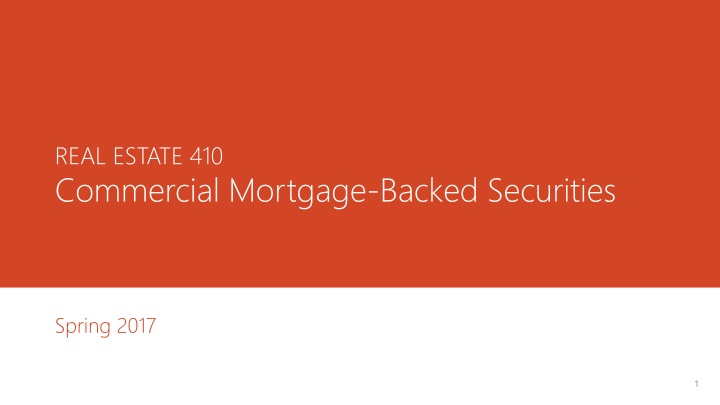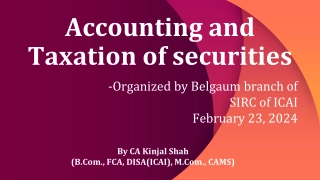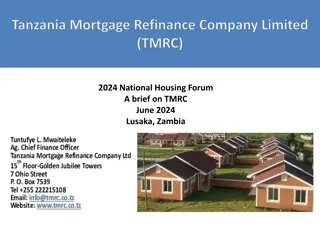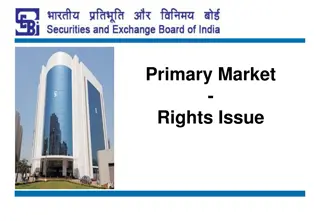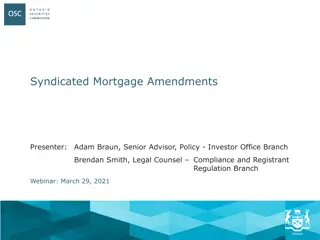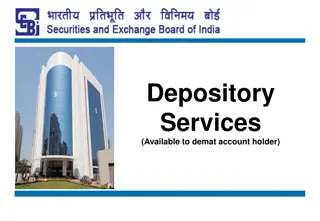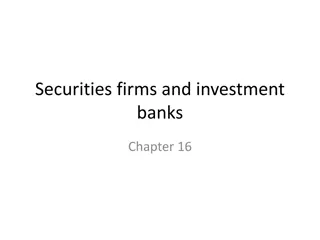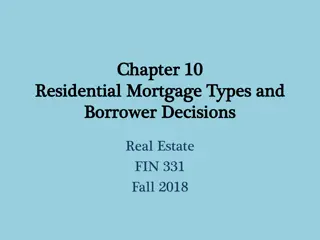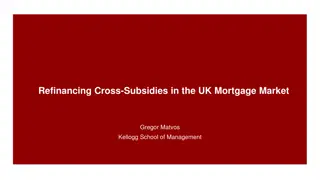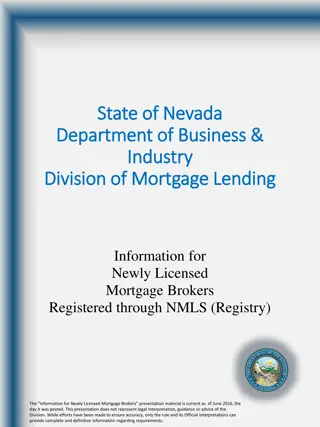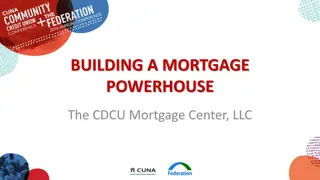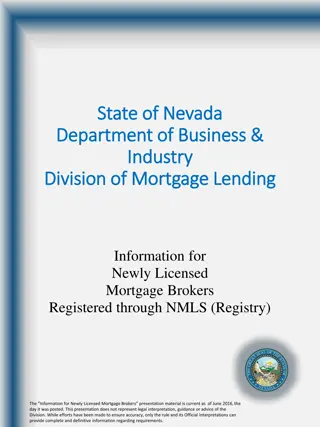Commercial Mortgage-Backed Securities
"Explore the evolution of Commercial Mortgage-Backed Securities (CMBS) including differences from Residential Mortgage-Backed Securities (RMBS), historical development, market dynamics before and after the financial crisis, and recent developments. Learn about CMBS structure, pricing, underwriting, and the role of credit rating agencies in this dynamic sector."
Download Presentation

Please find below an Image/Link to download the presentation.
The content on the website is provided AS IS for your information and personal use only. It may not be sold, licensed, or shared on other websites without obtaining consent from the author.If you encounter any issues during the download, it is possible that the publisher has removed the file from their server.
You are allowed to download the files provided on this website for personal or commercial use, subject to the condition that they are used lawfully. All files are the property of their respective owners.
The content on the website is provided AS IS for your information and personal use only. It may not be sold, licensed, or shared on other websites without obtaining consent from the author.
E N D
Presentation Transcript
REAL ESTATE 410 Commercial Mortgage-Backed Securities Spring 2017 1
Topics CMBS vs. RMBS History of CMBS Economics of CMBS CMBS structure CMBS pricing CMBS underwriting Role of credit rating agencies 2
Introduction CMBS vs. RMBS: CMBS are backed by commercial mortgages whereas RMBS use residential mortgages CMBS are similar in form to private-label RMBS, but Default risk differs significantly since these mortgages are not guaranteed by Fannie, Freddie, or Ginnie Prepayment not a major concern (at least during the lockout period) Assets in mortgage pool Often interest-only or balloon mortgages rather than fully amortizing mortgages 3
History of CMBS CMBS began to be developed in the late 1980 s and early 1990 s. The need of the Resolution Trust Corporation (RTC) to liquidate large commercial mortgage holdings by S&Ls is largely credited with being the catalyst for the large-scale development of these instruments. While RTC clearly helped spur the development of the market, it is also clear that CMBS development was part of a larger trend in securitization. 4
Development of CMBS Market 5 Source: Based on data from Commercial Mortgage Alert and Clodfelter (2005).
History of CMBS The preceding charts show how the CMBS market has evolved before the financial crisis. Commercial mortgage originations completely dried after the 2007 crisis and a number of commercial developer went under. While Fannie and Freddie kept financing flowing to housing, no similar market makers exist for commercial mortgage except for multifamily sector. But as the crisis subdued, commercial lending resumed, resulting in new CMBS deals. What is clear is that CMBS are here to stay. Like residential MBS they continue to grow, and continue to play an increasing role in the economy. 7
CMBS: Economics An important issue to address when analyzing a new type of instrument is what are the underlying economics that make the market need this instrument? What we really want to know is, what benefit do the various market participants get out of this, and at what cost? 10
CMBS: Economics First, we should identify the various market participants: Commercial borrowers Commercial mortgage originators CMBS issuers Commercial mortgage investors Ancillary participants Servicers Rating agencies 11
CMBS Securitization Process CMBS Securitization Process Trustee Oversees Pool Servicer (Master Svcr, Sub-Svcrs) Collects CF Special Servicer Deals with defaults, workouts 12
Economics of CMBS Commercial Borrowers: Ultimately, they get improved access to capital. In general this will translate into lower mortgage rates, and in tougher economic times, the ability to get funding at all (theoretically). They will have to deal with more constraints on mortgages, and probably more oversight regarding their ongoing operations. Perhaps less leniency if they have financial trouble. 13
Economics of CMBS Commercial Mortgage Originators Can specialize in originating loans, without having to invest in them long-term. Can replenish capital to continue to grow origination business. Can pick and choose which projects to invest in. Frequently CMBS will require originators to retain some form of credit risk, usually through maintaining an investment in the pool. Today many CMBS originators are parts of conduits ,that is, syndicates that are issuing loans for the express purpose of placing them into CMBS. 14
Economics of CMBS Commercial Mortgage Investors Liquidity They get marketable securities that can be sold into a liquid secondary market. Risk The structuring of CMBS is such that various risks are separated, thus allowing the investor to bear only risks they wish to bear. External Validation and Surveillance Rating agencies and larger market will help monitor the mortgage and the mortgage pool. 16
Economics of CMBS Master Servicer: Oversees the deal and servicing agreements Facilitates timely payment of principal and interest May provide (servicer) advances for delinquent and defaulted loans Business opportunities Sub-Servicer: Loan originator in a conduit deal who retains servicing Business opportunities 17
Economics of CMBS Special Servicer: Becomes engaged when loan more than 60 days delinquent. Has the authority to: Extend the loan Modify or restructure the loan Foreclose on the property on behalf of the trustee Generally, master servicer and special servicer are different. But it is possible they are the same. 18
Economics of CMBS Ultimately, the entire CMBS market relies upon its ability to provide two services: Liquidity Risk management Two separate facets of CMBS permit this: Securitization: Provides the liquidity Structure: Provides the risk management Focus is on structure 19
CMBS: Structure All mortgages contain multiple sources of risk: Prepayment risk The risk interest rates will rise, also referred to as extension risk Default risk These risks tend to be negatively correlated with each other. i.e. you never catch a break Investors buying a whole commercial loan must bear all of these risks. 20
CMBS Structure CMBS are structured in such a way as to segregate these risks into various tranches of the security, allowing investors to select which risk they wish to bear. Investors are willing to pay a premium (relative to the price of the underlying whole loans) to select the risk they wish to bear. On top of this, the structuring of the CMBS also allows the creation of assets with varying maturities and varying credit-risk. This allows for a wide range of discount rates (credit spreads) for assets created from whole loans of a given maturity and creditworthiness. 21
CMBS Structure The typical CMBS is structured in a manner that is very similar to the residential CMO structure discussed earlier. Usually there are a series of sequential pay tranches, occasionally with a companion bond (i.e. PAC, TAC, etc.) Unlike with a residential CMO, however, there is not a more primitive security underlying the CMBS: the underlying mortgages are whole loans rather than mortgage pass-through securities. 22
CMBS Structure A couple of other points to keep in mind: Usually there is a lockout period to prevent prepayments. If there is not a lockout period, then usually prepayment penalties are sufficiently onerous to remove the prepayment incentive. The terms of commercial mortgages tend to be shorter (less than 20 years) than that of residential mortgages. Frequently the commercial loan will amortize over a longer period that the term of the loan. This results in a balloon note being due at maturity. 23
CMBS Structure With a sequential structure, a series of tranches (slices) are created and assigned a priority. Each tranche has a principal and a coupon associated with it. Each month when payments are received, all principal (including prepayments and principal recoveries, if any) goes to the most senior tranche, until it is paid off. Then the second- most senior tranche begins to receive all principal until it is paid, etc. 24
CMBS Structure Typically, interest is paid to each tranche each period, based upon its coupon and principal balance outstanding. Except if there is an accrual tranche (not typical). Typically there is one IO tranche which receives all left over interest (if any) each month. This tranche is often referred to as the residual or equity tranche. 25
CMBS Structure So what this does is assign receipt of principal to the tranches by the order in which they receive it. Let s assume that we had a $100M CMBS, with four tranches: Tranche A: $45M, 6.5% (senior tranche) Tranche B: $35M, 6.75% (mezzanine tranche) Tranche C: $20M, 7.0% (junior tranche) IO Tranche (residual or equity tranche) 26
CMBS Structure Normally, The top few tranches are called the senior tranches. The middle tranches are the mezzanine tranches. The most junior tranches are the subordinate or first loss tranches. How is default dealt with in the CMBS structure? Nothing in the previous structure so far creates any altering of default risk. Normally what happens is that any defaulted principal is deducted from the principal owed to the least senior tranche. If all principal owed to the last tranche defaults, then the next least-senior tranche starts having principal deducted. 27
CMBS Structure Prepayments affect the most senior tranches and work their way down This is commonly referred to as the waterfall Prepayments Tranche A Tranche B Losses from defaults are assigned the most junior tranche and work their way up But any principal recoveries are paid to the most senior tranche Tranche C Residual Losses 28
CMBS Structure Thus, the CMBS allows one, essentially, to trade default risk for prepayment risk. Remember, however, that most of the underlying commercial mortgages probably will not allow prepayment, especially in the early years of the mortgage, when the most senior tranches are being paid down. Other methods for reducing the default risk: Credit derivatives Insurance Overcollateralization 29
Typical CMBS Structure Whole Loan Pool CMBS Interest Principal Rating Sub DSCR LTV Spread Rating Sub DSCR LTV Spread BBB 0% 1.40 75% 250 BP AAA 30% 2.00 52.50% 136 BP AA 24% 1.84 57.00% 156 BP A 18% 1.71 61.50% 176 BP BBB 11% 1.57 66.75% 240 BP BB 6% 1.49 70.50% 535 BP B 3% 1.44 72.75% 825 BP NR 0% 1.40 75.00% 2200 BP Borrower Equity Borrower Equity Losses 30
Prepayment Protection Four major types of prepayment protection, listed in order from most to least protective: 1. Hard Lockout: Forbids prepayment prior to loan maturity. 2. Defeasance: Borrower must purchase T-Bond strips to provide lender with same cash flows as mortgage for remaining life of mortgage.* (T-Bond collateral substitutes property collateral, resulting in lower default risk, hence increased value for lender.) 3. Yield Maintenance Provision: Borrower pays a make whole penalty to lender. Typical requirement would be penalty equal to PV of difference between loan interest and current T-Bond interest (for bond of maturity equal to remaining maturity on loan), with the PV calculated based on T-Bond yield as the discount rate. 4. Fixed Percentage Penalty Points: Borrower pays stated percentage over the OLB on the loan. NB: Many loans mix two or more of the above. (e.g., lockout period followed by points penalty that declines with further age of loan.) 31
CMBS Pricing Now that we have an idea of how CMBS are structured, we can examine how they are priced. In one sense, pricing CMBS is no different than any other financial asset. Lay out the cash flows. Discount the cash flows at an appropriate rate. 33
CMBS Pricing The difficulty is, of course, that we do not know what future prepayments or default will be. Accurate pricing required the development of prepayment and default models, usually based upon regression analysis of historical data. Remember, default was not an issue for agency MBS and related CMOs and did not need to be modeled. 34
CMBS Pricing Further, since prepayment, and, to a lesser degree, default, are functions of interest rates, one also needs to model their evolution as well. Typically this is done by specifying a diffusion process for interest rates and then using Monte Carlo simulation to model their movement through time. 35
CMBS Pricing What is instructive, however, is to note the relative spread between various CMBS tranches and Treasury spreads. For example: AAA 90 bps AA 120 bps BBB - 200 bps B 450 bps D 900 bps 36
CMBS: Pricing Closely related to the notion of pricing is the assignment of ratings. This is done by outside agencies such as S&P or Moody s, using the same basic systems that each uses for corporate bonds. Assignment of ratingscan make or break an issuance. 37
CMBS Rating What is interesting is how many factors have to go into the credit rating decision: Is there credit support on the pool (e.g., overcollateralization, insurance, guarantee)? What are the LTV and DSR ratios? Quality of underwriting? What is the quality of the information? How much exposure is there to one property or one borrower, or even one lender/servicer. What is reputation of issuer? 38
CMBS Underwriting Key underwriting characteristics for commercial mortgages: Debt Service Coverage Ratio (DSCR) Loan to Value Ratio (LTV) Average loan size Max loan not to exceed certain percentage (e.g. 5%) Diversification across Property types Geographic locations Prepayment terms Loan maturities 39
Role of Rating Agencies Endorse the CMBS structure by assigning initial credit ratings Establish different rating criteria for various property types Negotiate subordination levels with issuers Track property performance and delinquencies Servicer and trustee report ongoing loan level performance Monthly and quarterly DSCRs Occupancy levels Updated bond information Issue periodic surveillance reports 40
Summary CMBS have unique investment characteristics (relatively little prepayment risk, relatively high yields) that appeal to important classes of investors, thereby increasing the capital available to real estate, and improving the efficiency of the functioning of the capital market for investors. Variety in the risk and return attributes of the securities carved out of a mortgage pool allow different tranches to appeal to different types of investors. The CMBS market is another example of how investor heterogeneity drives the investment industry. Typically, the investment-grade tranches that make up the bulk of a typical CMBS issue find ready buyers in the form of conservative institutions such as pension funds, life insurance companies, and bond mutual funds. 41
Summary The market for the more risky speculative and junk tranches is much thinner. Major buyers and holders of the lower tranches are aggressive investors willing to take on risk for high expected returns, and who typically have specialized knowledge and expertise regarding commercial property risk. Such investors have included the investment banks and conduits issuing the CMBS, the special servicers who are charged with taking over defaulted loans in the pool to attempt workouts with the borrowers, and specialized mortgage REITs. 42
Next: Income Properties 43
